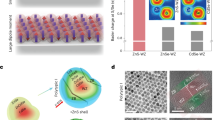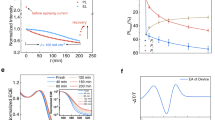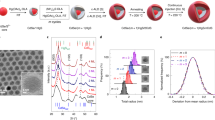Abstract
Infrared light-emitting diodes are currently fabricated from direct-gap semiconductors using epitaxy, which makes them expensive and difficult to integrate with other materials. Light-emitting diodes based on colloidal semiconductor quantum dots, on the other hand, can be solution-processed at low cost, and can be directly integrated with silicon1. However, so far, exciton dissociation and recombination have not been well controlled in these devices, and this has limited their performance2,3,4,5,6,7,8. Here, by tuning the distance between adjacent PbS quantum dots, we fabricate thin-film quantum-dot light-emitting diodes that operate at infrared wavelengths with radiances (6.4 W sr−1 m−2) eight times higher and external quantum efficiencies (2.0%) two times higher than the highest values previously reported. The distance between adjacent dots is tuned over a range of 1.3 nm by varying the lengths of the linker molecules from three to eight CH2 groups, which allows us to achieve the optimum balance between charge injection and radiative exciton recombination. The electroluminescent powers of the best devices are comparable to those produced by commercial InGaAsP light-emitting diodes. By varying the size of the quantum dots, we can tune the emission wavelengths between 800 and 1,850 nm.
This is a preview of subscription content, access via your institution
Access options
Subscribe to this journal
Receive 12 print issues and online access
$259.00 per year
only $21.58 per issue
Buy this article
- Purchase on Springer Link
- Instant access to full article PDF
Prices may be subject to local taxes which are calculated during checkout




Similar content being viewed by others
References
Cho, K. et al. High-performance crosslinked colloidal quantum-dot light-emitting diodes. Nature Photon. 3, 341–345 (2009).
Colvin, V. L., Schlamp, M. C. & Alivisatos, A. P. Light-emitting diodes made from cadmium selenide nanocrystals and a semiconducting polymer. Nature 370, 354–357 (1994).
Coe, S., Woo, W., Bawendi, M. & Bulović, V. Electroluminescence from single monolayers of nanocrystals in molecular organic devices. Nature 420, 800–803 (2002).
Tessler, N., Medvedev, V., Kazes, M., Kan, S. & Banin, U. Efficient near-infrared polymer nanocrystal light-emitting diodes. Science 295, 1506–1508 (2002).
Steckel, J. S., Coe-Sullivan, S., Bulović, V. & Bawendi, M. G. 1.3 µm to 1.55 µm tunable electroluminescence from PbSe quantum dots embedded within an organic device. Adv. Mater. 15, 1862–1866 (2003).
Caruge, J. M., Halpert, J. E., Wood, V., Bulović, V. & Bawendi, M. G. Colloidal quantum-dot light-emitting diodes with metal-oxide charge transport layers. Nature Photon. 2, 247–250 (2008).
Bourdakos, K. N., Dissanayake, D. M. N. M., Lutz, T., Silva, S. R. P. & Curry, R. J. Highly efficient near-infrared hybrid organic–inorganic nanocrystal electroluminescence device. Appl. Phys. Lett. 92, 153311 (2008).
Konstantatos, G., Huang, C., Levina, L., Lu, Z. & Sargent, E. H. Efficient infrared electroluminescent devices using solution-processed colloidal quantum dots. Adv. Funct. Mater. 15, 1865–1869 (2005).
Wise, F. W. Lead salt quantum dots: the limit of strong quantum confinement. Acc. Chem. Res. 33, 773–780 (2000).
Choi, J. J. et al. PbSe nanocrystal excitonic solar cells. Nano Lett. 9, 3749–3755 (2009).
Konstantatos, G. et al. Ultrasensitive solution-cast quantum dot photodetectors. Nature 442, 180–183 (2006).
Huang, H., Dorn, A., Nair, G. P., Bulović, V. & Bawendi, M. G. Bias-induced photoluminescence quenching of single colloidal quantum dots embedded in organic semiconductors. Nano Lett. 7, 3781–3786 (2007).
Choi, J. J. et al. Photogenerated exciton dissociation in highly coupled lead salt nanocrystal assemblies. Nano Lett. 10, 1805–1811 (2010).
Hyun, B. R. et al. Electron injection from colloidal PbS quantum dots into titanium dioxide nanoparticles. ACS Nano 2, 2206–2212 (2008).
Verbakel, F., Meskers, S. C. J. & Janssen, R. A. J. Electronic memory effects in diodes of zinc oxide nanoparticles in a matrix of polystyrene or poly(3-hexylthiophene). J. Appl. Phys. 102, 083701 (2007).
Kepler, R. G. et al. Electron and hole mobility in tris(8-hydroxyquinolinolato-N1,O8) aluminum. Appl. Phys. Lett. 66, 3618–3620 (1995).
Shimizu, K. T., Woo, W. K., Fisher, B. R., Eisler, H. J. & Bawendi, M. G. Surface-enhanced emission from single semiconductor nanocrystals. Phys. Rev. Lett. 89, 117401 (2002).
Barkhouse, D. A., Kramer, I. J., Wang, X. & Sargent, E. H. Dead zones in colloidal quantum dot photovoltaics: evidence and implications. Opt. Express 18, A451–A457 (2010).
Murray, C. B., Kagan, C. R. & Bawendi, M. G. Synthesis and characterization of monodisperse nanocrystals and close-packed nanocrystal assemblies. Annu. Rev. Mater. Sci. 30, 545–610 (2000).
Hines, M. A. & Scholes, G. D. Colloidal PbS nanocrystals with size-tunable near-infrared emission: observation of post-synthesis self-narrowing of the particle size distribution. Adv. Mater. 15, 1844–1849 (2003).
Semonin, O. E. et al. Absolute photoluminescence quantum yields of IR-26 dye, PbS, and PbSe quantum dots. J. Phys. Chem. Lett. 1, 2445–2450 (2010).
Malliaras, G. G., Salem, J. R., Brock, P. J. & Scott, C. Electrical characteristics and efficiency of single-layer organic light-emitting diodes. Phys. Rev. B 58, R13411–R13414 (1998).
Malliaras, G. G. & Scott, J. C. The roles of injection and mobility in organic light emitting diodes. J. Appl. Phys. 83, 5399–5403 (1998).
Pattantyus-Abraham, A. G. et al. Depleted-heterojunction colloidal quantum dot solar cells. ACS Nano 4, 3374–3380 (2010).
Talapin, D. V. & Murray, C. B. PbSe nanocrystal solids for n- and p-channel thin film field-effect transistors. Science 310, 86–89 (2005).
Law, M. et al. Structural, optical, and electrical properties of PbSe nanocrystal solids treated thermally or with simple amines. J. Am. Chem. Soc. 130, 5974–5985 (2008).
Greenham, N. C., Friend, R. H. & Bradley, D. D. C. Angular dependence of the emission from a conjugated polymer light-emitting diode: implications for efficiency calculations. Adv. Mater. 6, 491–494 (1994).
Acknowledgements
This material is based on work supported by the National Science Foundation (NSF, grant no. EEC-0646547) and by the New York State Foundation for Science, Technology and Innovation (NYSTAR). J.J.C. and D.S. acknowledge support from the Cornell Center for Materials Research with funding from IGERT: a Graduate Traineeship in Nanoscale Control of Surfaces and Interfaces (DGE-0654193) of the NSF. This publication is based on work supported in part by an award (no. KUS-C1-018-02) made by King Abdullah University of Science and Technology (KAUST). GISAXS measurements were conducted at Cornell High Energy Synchrotron Source (CHESS) and the authors thank D.-M. Smilgies for calibration of the beam line set-up.
Author information
Authors and Affiliations
Contributions
L.S. and J.J.C. conceived and designed the experiments. L.S. and D.S. performed device characterization and optical measurements. J.J.C. synthesized the materials, fabricated the devices, and performed GISAXS and optical measurements. A.C.B. calculated the energy levels of the quantum dots. L.S. and F.W.W. co-wrote the paper. F.W.W., T.H. and G.G.M. (now at Ecole Nationale Supérieure des Mines, France) supervised the project. All authors discussed the work, commented on the manuscript and contributed to revision of the manuscript.
Corresponding authors
Ethics declarations
Competing interests
The authors declare no competing financial interests.
Supplementary information
Supplementary information
Supplementary information (PDF 2098 kb)
Rights and permissions
About this article
Cite this article
Sun, L., Choi, J., Stachnik, D. et al. Bright infrared quantum-dot light-emitting diodes through inter-dot spacing control. Nature Nanotech 7, 369–373 (2012). https://doi.org/10.1038/nnano.2012.63
Received:
Accepted:
Published:
Issue Date:
DOI: https://doi.org/10.1038/nnano.2012.63
This article is cited by
-
Switchable interfacial reaction enables bright and stable deep-red perovskite light-emitting diodes
Nature Photonics (2024)
-
Bright and stable near-infrared lead-free perovskite light-emitting diodes
Nature Photonics (2024)
-
Inorganic Halide Perovskite Quantum Dots: A Versatile Nanomaterial Platform for Electronic Applications
Nano-Micro Letters (2023)
-
Polyatomic molecules with emission quantum yields >20% enable efficient organic light-emitting diodes in the NIR(II) window
Nature Photonics (2022)
-
Ultrafast exciton transport at early times in quantum dot solids
Nature Materials (2022)



